
NASA-5 Biographies
| Foale | Tsibliev | Lazutkin | Solovyev | Vinogradov |
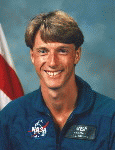 Mike
Foale Biography
Mike
Foale Biography
NAME: : C. Michael Foale (Ph.D.) NASA Astronaut
PERSONAL DATA: Born January 6, 1957, in Louth, England, but considers Cambridge, England, to be his hometown. Married to the former Rhonda R. Butler of Louisville, Kentucky. They have two children. He enjoys many outdoor activities, particularly wind surfing. Private flying, soaring, and project scuba diving have been his other major sporting interests. He also enjoys exploring theoretical physics and writing children's software on a personal computer. His parents, Colin and Mary Foale, reside in Cambridge, England. Her parents, Reed & Dorothy Butler, reside in Louisville, Kentucky.
EDUCATION: Graduated from Kings School, Canterbury, in 1975. He attended the University of Cambridge, Queens College, receiving a bachelor of arts degree in Physics, Natural Sciences Tripos, with 1st class honors, in 1978. While at Queens College, he completed his doctorate in Laboratory Astrophysics at Cambridge University in 1982.
EXPERIENCE: While a postgraduate at Cambridge University, Foale participated in the organization and execution of scientific scuba diving projects. Pursuing a career in the U.S. Space Program, Foale moved to Houston, Texas, to work on Space Shuttle navigation problems at McDonnell Douglas Aircraft Corporation. In June 1983, Foale joined NASA Johnson Space Center in the payload operations area of the Mission Operations Directorate. In his capacity as payload officer in the Mission Control Center, he was responsible for payload operations on Space Shuttle missions STS-51G, 51-I, 61-B and 61-C.
NASA EXPERIENCE: Selected as an astronaut candidate by NASA in June 1987. Before his first flight he flew the Shuttle Avionics Integration Laboratory (SAIL) simulator to provide verification and testing of the Shuttle flight software, and later developed crew rescue and integrated operations for International Space Station Alpha. Foale has served as Deputy Chief of the Mission Development Branch in the Astronaut Office, and Head of the Astronaut Office Science Support Group. In preparation for a long-duration flight on the Russian Space Station Mir, Foale trained at the Cosmonaut Training Center, Star City, Russia. A veteran of five space flights, Foale has logged over 168 days in space including three space walks totaling 18 hours and 49 minutes. He was a mission specialist on STS-45, STS-56, STS-63 and STS-103, and served as Board Engineer 2 on Mir-24 (ascent on STS-84 and return on STS-86). He currently serves as Chief of the Astronaut Office Expedition Corps, while continuing his duties as Assistant Director (Technical), Johnson Space Center.
STS-45 (March 24 to April 2, 1992) was the first of the ATLAS series of missions to address the atmosphere and its interaction with the Sun.
STS-56 (April 9-17, 1993) carried ATLAS-2 and the SPARTAN retrievable satellite which made observations of the solar corona.
STS-63 (February 2-11, 1995) was the first rendezvous with the Russian Space Station Mir. During the flight he made a space walk (extravehicular activity) for 4 hours, 39 minutes, evaluating the effects of extremely cold conditions on his spacesuit, as well as moving the 2800-pound Spartan satellite as part of a mass handling experiment.
Foale next spent 4-½ months aboard the Russian Space Station Mir. He launched with the crew of STS-84 aboard Space Shuttle Atlantis on May 15, 1997. Following docking, he joined the crew aboard Mir on May 17, 1997. Foale spent the following 134 days conducting various science experiments and helping the crew resolve and repair numerous malfunctioning systems. On September 6, 1997 he and Commander Anatoly Solovyev conducted a 6-hour EVA to inspect damage to the station's Spektr module caused by the June 25 collision with a Progress resupply ship. Foale returned on October 6, 1997 with the crew of STS-86 aboard Space Shuttle Atlantis.
Most recently he served aboard STS-103 (December 19-27, 1999), an 8-day mission during which the crew successfully installed new instruments and upgraded systems on the Hubble Space Telescope (HST). During an 8 hours and 10 minute EVA, Foale and Nicollier replaced the telescopes main computer and Fine Guidance Sensor. The STS-103 mission was accomplished in 120 Earth orbits, traveling 3.2 million miles in 191 hours and 11 minutes.
_______________________________________________________________
| Foale | Tsibliev | Lazutkin | Solovyev | Vinogradov |
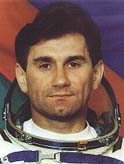 Vasily
Tsibliev Biography
Vasily
Tsibliev Biography
Vasily Tsibliev was the commander of the Mir-23 mission, which lasted from February 10, 1997, until August 14, 1997. He and Mir-23 Flight Engineer Aleksandr Lazutkin worked with two American astronauts on the space station, beginning with Jerry Linenger. Linenger's mission began with the launch of the Space Shuttle Atlantis on January 12, 1997, and ended when he returned to Earth on May 24, 1997. He was replaced by Michael Foale, whose mission started with the launch of the Space Shuttle Atlantis on May 15, 1997, and came to a close when he returned to Earth on October 6, 1997.
Tsibliev was born February 20, 1954 in Orekhovka, Krim Oblash, Ukraine. He is married with two children.
He was selected to be a pilot cosmonaut on March 26, 1987 and retired on June 19 1998.
Tsibliev graduated from Kharkov Military School of Aviation in 1975 from Gagarin Air Force Academy. He acheived the rank of Lieutenant Colonel in the Russian Air Force and resigned from active duty on December 25, 1997.
As of May 2000 he was the First Deputy Commander at the Gagarin Cosmonaut Training Center.
_______________________________________________________________
| Foale | Tsibliev | Lazutkin | Solovyev | Vinogradov |
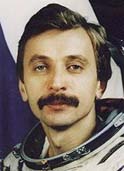 Aleksandr
Lazutkin Biography
Aleksandr
Lazutkin Biography
Aleksandr Lazutkin was the flight engineer of the Mir-23 mission, which lasted from February 10, 1997, until August 14, 1997. He and Mir-23 Commander Vasily Tsibliev worked with two American astronauts on the space station, beginning with Jerry Linenger. Linenger's mission began with the launch of the Space Shuttle Atlantis on January 12, 1997, and ended when he returned to Earth on May 24, 1997. He was replaced by Michael Foale, whose mission started with the launch of the Space Shuttle Atlantis on May 15, 1997, and came to a close when he returned to Earth on October 6, 1997.
Lazutkin was born October 30, 1957 in Moscow, Russia. He is married with two children.
He was selected to be a cosmonat on March 3, 1992 and became a flight engineer. Lazutkin graduated from Moscow Aviation Institute with a mechanical engineering degree and he worked with NPO Energia.
_______________________________________________________________
| Foale | Tsibliev | Lazutkin | Solovyev | Vinogradov |
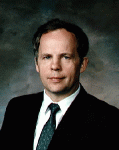 Anatoly
Solovyev Biography
Anatoly
Solovyev Biography
Anatoly Solovyev commanded two Mir flights during the Shuttle-Mir Program. The first was Mir 19, where he was in charge of the Russian crew that replaced Norm Thagard and his Mir-18 cosmonaut crewmates. Solovyev and Mir 19 Flight Engineer Nikolai Budarin launched to the Russian space station aboard a Space Shuttle on STS-71, marking the first time a Mir crew was ferried to the station on an American spacecraft. Additionally, Solovyev was the commander of the Mir-24 mission, which lasted from August 5, 1997, until February 19, 1998. He and Mir-24 Flight Engineer Pavel Vinogradov worked with two American astronauts on the space station, beginning with Michael Foale. Foale's mission began with the launch of the Space Shuttle Atlantis on May 15, 1997, and ended when he returned to Earth on October 6, 1997. He was replaced by David Wolf, whose mission started with the launch of the Space Shuttle Endeavour on September 25, 1997, and came to a close when he returned to Earth on January 31, 1998.
Solovyev graduated from Lenin Komsomol Chernigov Higher Military Aviation School in 1972 and was a Colonel and test pilot for the Soviet Air Force. He was selected as cosmonaut on December 1, 1978 and completed his general space training in 1979. He is a veteran of five spaceflights and has made a record 15 EVAs, spending a total of 74 hours and 41 minutes space walking. Solovyev also commanded Mir during David Wolf's stay, and Wolf indicated high praise for Solovyev in his Oral History: "I never dreamed [my first space walk] would be from a Russian spacecraft, in a Russian spacesuit, speaking Russian with a Russian who had been out sixteen times, the most experienced space walker in the world, and that's what Anatoly Solovyev is. So it was a real first-hand lesson from the number-one guy in the field, and that was a privilege."
_______________________________________________________________
| Foale | Tsibliev | Lazutkin | Solovyev | Vinogradov |
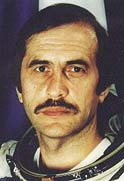 Pavel
Vinogradov Biography
Pavel
Vinogradov Biography
Pavel Vinogradov was the flight engineer of the Mir-24 mission, which lasted from August 5, 1997, until February 19, 1998. He and Mir-24 Commander Vladimir Solovyev worked with two American astronauts on the space station, beginning with Michael Foale. Foale's mission began with the launch of the Space Shuttle Atlantis on May 15, 1997, and ended when he returned to Earth on October 6, 1997. He was replaced by David Wolf, whose mission started with the launch of the Space Shuttle Endeavour on September 25, 1997, and came to a close when he returned to Earth on January 31, 1998.
Vinogradov was born August 31, 1953 in Magadan, Magadan Oblast, Russia. He is married with three children.
Vinogradov graduated from Moscow Aviation Institute and was selected to become a cosmonaut on March 3, 1992.